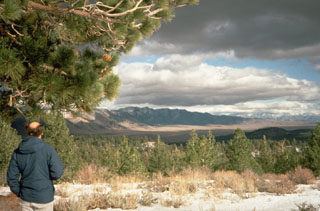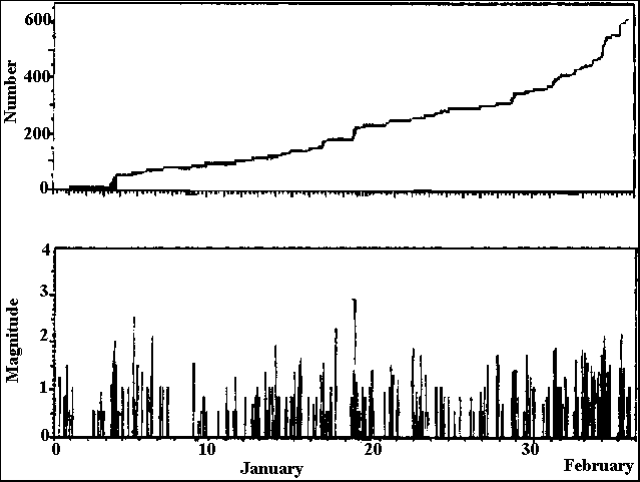Report on Long Valley (United States) — January 1990
Bulletin of the Global Volcanism Network, vol. 15, no. 1 (January 1990)
Managing Editor: Lindsay McClelland.
Long Valley (United States) Continued swarm-like activity on S margin of resurgent dome and S moat; brief swarm at Mammoth Mountain
Please cite this report as:
Global Volcanism Program, 1990. Report on Long Valley (United States) (McClelland, L., ed.). Bulletin of the Global Volcanism Network, 15:1. Smithsonian Institution. https://doi.org/10.5479/si.GVP.BGVN199001-323822
Long Valley
United States
37.7°N, 118.87°W; summit elev. 3390 m
All times are local (unless otherwise noted)
"Swarm-like activity of magnitude greater than or equal to 2 earthquakes along the S margin of the resurgent dome and S moat continued to increase through January and early February (figure 11). During the same period, Mammoth Mountain, on the SW rim of the caldera, remained relatively quiet except for a brief burst of activity beneath the mountain's N flank on 19 January that included a locally felt earthquake of about M 3." A preliminary report on the Mammoth Mountain swarm will appear in the April issue of the Bulletin of the Seismological Society of America (see Reference, below).
"Activity within the caldera continues to occur in much the same area as the recurring swarms of the early 1980's, although the current activity shows a tendency to be concentrated somewhat farther N beneath the resurgent dome and along its W and E margins. Focal depths range from roughly 8 to <3 km as during the earlier activity. This increased swarm activity within the caldera no doubt reflects the 5-fold increase in extensional strain rate across the resurgent dome, detected by repeated measurements of the 2-color geodimeter network that spans the central section of the caldera. The strain rate increase began in September and has continued through January at a rate of ~5 microstrain/year."
Reference. Hill, D.P., Ellsworth, W.L., Johnston, M.J.S., Langbein, J.O., Oppenheimer, D.H., Pitt, A.M., Reasenberg, P.A., Sorey, M.L., and McNutt, S.R., 1990, The 1989 Earthquake Swarm Beneath Mammoth Mountain, California: An Initial Look at the 4 May through 30 Sep Activity: Bulletin of the Seismological Society of America, v. 80, p. 325-339.
Geological Summary. The large 17 x 32 km Long Valley caldera east of the central Sierra Nevada Range formed as a result of the voluminous Bishop Tuff eruption about 760,000 years ago. Resurgent doming in the central part of the caldera occurred shortly afterwards, followed by rhyolitic eruptions from the caldera moat and the eruption of rhyodacite from outer ring fracture vents, ending about 50,000 years ago. During early resurgent doming the caldera was filled with a large lake that left strandlines on the caldera walls and the resurgent dome island; the lake eventually drained through the Owens River Gorge. The caldera remains thermally active, with many hot springs and fumaroles, and has had significant deformation, seismicity, and other unrest in recent years. The late-Pleistocene to Holocene Inyo Craters cut the NW topographic rim of the caldera, and along with Mammoth Mountain on the SW topographic rim, are west of the structural caldera and are chemically and tectonically distinct from the Long Valley magmatic system.
Information Contacts: D. Hill, USGS Menlo Park.


